Documents examined by the Chronicle show the state has purchased 932 other fasteners for the bridge in the past five years that—like the failed bolts—were made of high-strength, galvanized steel.
"This is completely the wrong material for use in this application," Charles McMahon, emeritus professor of materials science at the University of Pennsylvania, told the Chronicle. "I have devoted decades of my career to studying this. This steel is almost guaranteed to give you cracking under these conditions."
The American Association of State Highway Transportation Officials, a national organization that sets standards for steel used in large highway structures, bans high-strength, galvanized bolts for bridges, the Chronicle said.
Last year, the Federal Highway Administration warned the state highway officials group about galvanizing such hardened steel for bridge use. Such bolts "are susceptible to possible stress corrosion cracking and embrittlement during galvanizing," the federal agency said.
But Caltrans said in a statement to the Associated Press said that it used standards set by the American Society for Testing and Materials, an organization that, according to its website, develops and disseminates high-quality standards and technical information.
"The design team determined that in this application, American Society for Testing and Materials standards were appropriate. We ordered the steel consistent with those standards and in a way to guard against hydrogen embrittlement," Caltrans Director Malcolm Dougherty said in the statement.
"In March, bolts broke at one location and we're going to solve that problem. If that means replacing more rods, that's what we'll do. We're taking a very thorough and methodical approach that is based on scientific evidence and rigorous testing," the statement said.
